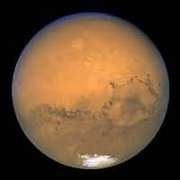Spirit Surveys Local Terrian For Winter Of 2006

Just in time to survive the Martian winter, NASA's once-again-lucky Spirit rover has driven to and parked on a north-facing slope in the Columbia Hills.
Spirit acquired the images in the mosaic above with its navigation camera on April 11, the rover's 807th Martian day, or sol, of exploring Gusev Crater on Mars. Approaching from the east are the rover's tracks, including a shallow trench created by the dragging front wheel.
On the horizon, to the left, is McCool Hill, one of the seven Columbia Hills, named for the crew of the space shuttle. This view is presented in a cylindrical projection with geometric seam correction.
This vantage point will help to maximize the power output from its solar cells during the period of weaker sunlight and guarantee Spirit's ability to communicate with NASA's Mars Odyssey orbiter.
Top science priorities for the rover in the coming months include taking a detailed, 360-degree image using all 13 filters of its panoramic camera, studying surface and subsurface soil properties, and monitoring the atmosphere and its changes.
The planned subsurface soil experiments will be a first for the Mars Exploration Rover mission. To conduct the study, Spirit will use the brush on its rock abrasion tool - or RAT - to sweep soil away carefully, much as an archaeologist uses a brush to uncover artifacts.
At each level, Spirit will measure the mineral and chemical properties and assess the physical nature - such as grain size, texture and hardness - of the material, using the Athena science instruments on its robotic arm.
Mission scientists are particularly interested in the vertical variations of soil characteristics that could indicate water-related deposits of sulfates and other minerals.
The panoramic images will provide important information about the nature and origin of surrounding rocks and soils. Spirit also will study the mineralogy of the surrounding terrain using its thermal emission spectrometer, and the rover will search for surface changes caused by high winds.
After the winter solstice in August, depending on energy levels, controllers at Jet Propulsion Laboratory could direct the rover to pivot around its disabled right-front wheel to bring different targets within reach of the arm. When the winter season ends and solar energy levels rise again, controllers will direct Spirit to resume examining other areas of Columbia Hills.
Copyright 2006 by Space Daily, Distributed United Press International





















